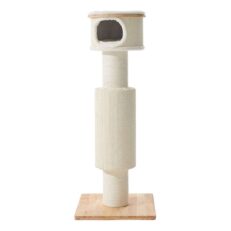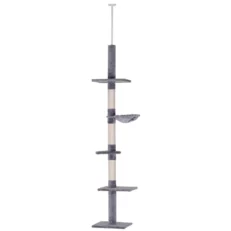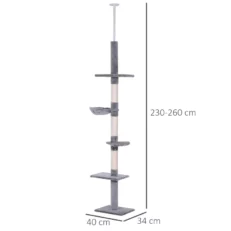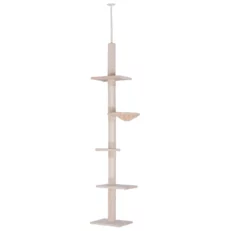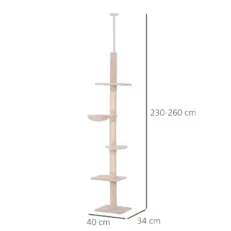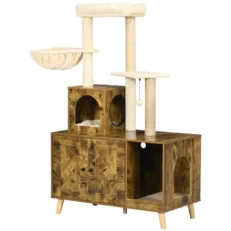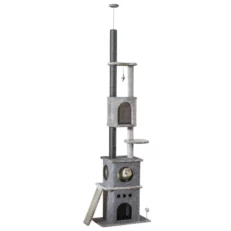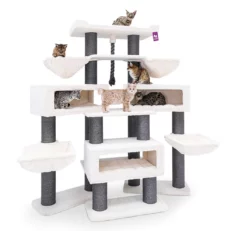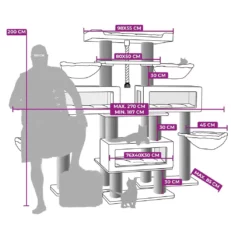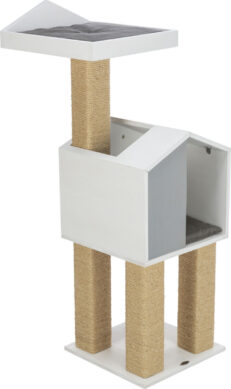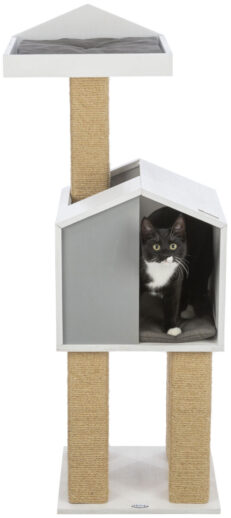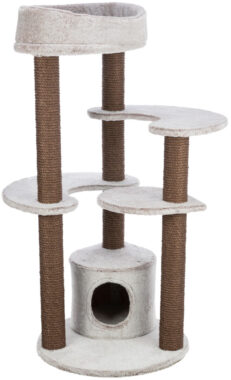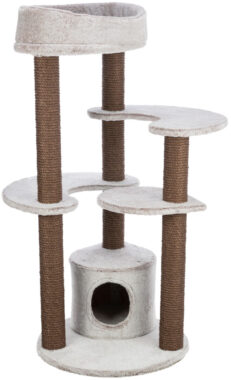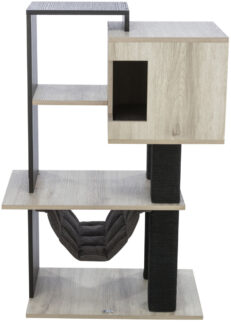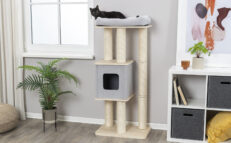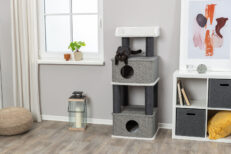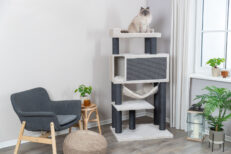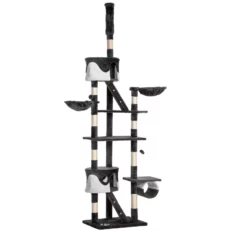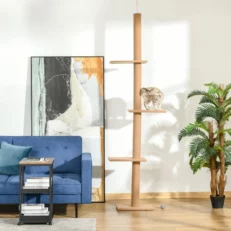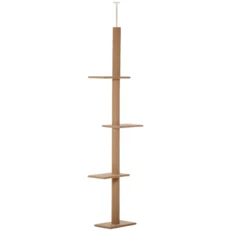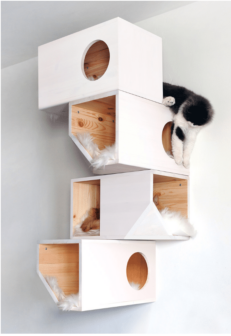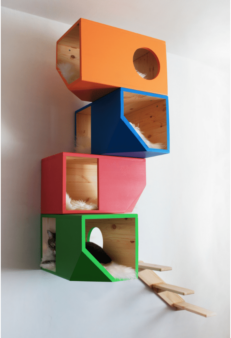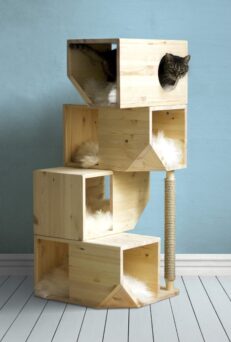
Arthritis, a condition commonly associated with aging, is not exclusive to humans; it also significantly affects the feline population. The prevalence of arthritis in cats is more common than many might expect, especially as they enter their senior years. This degenerative joint disease can greatly impact a cat’s quality of life, leading to pain, decreased mobility, and a reduction in the joyful activities that once brought pleasure to their daily routines.
Cats are masters at masking discomfort, but signs of arthritis may include reluctance to jump or climb, noticeable stiffness upon waking, diminished activity levels, or even behavioral changes such as increased irritability. The progression of arthritis can slowly encroach upon a cat’s independence, making even simple movements challenging and painful.
Highlight the importance of selecting a cat tree that caters to their condition
For cats suffering from arthritis, the design and functionality of a cat tree take on heightened significance. The right cat tree for an arthritic cat should not only offer enjoyment but also support their health needs. Features such as low-rise steps, ample resting platforms, supportive cushioning, and easy-to-navigate layout are crucial. The goal is to minimize strain on their joints while still encouraging gentle movement to maintain muscle strength and flexibility.
Moreover, the cat tree should have a stable and sturdy base, allowing cats to feel secure in their movements, without the wobble or shake that might deter them from attempting to climb. The incorporation of ramps or steps can be particularly beneficial, facilitating access to higher levels without the need for jumping.
In the following blog post, we will explore the various considerations and options for selecting a cat tree that accommodates the needs of a cat with arthritis. This discussion will serve as a supportive guide for pet parents who face the challenge of adapting their home to their arthritic cat’s needs, aiming to enhance their pet’s comfort and mobility.
We will provide recommendations for features to look for, share tips on how to introduce your cat to a new tree, and discuss additional ways to manage arthritis symptoms at home. This post is dedicated to helping you find a solution that brings back a sense of joy and adventure to your cat’s life, despite their condition. Join us as we help you create a loving and comfortable environment for your feline companion, ensuring they continue to thrive even with arthritis.
Understanding Arthritis in Cats
Arthritis is a common ailment in aging cats, and it can significantly impact their quality of life. To ensure the well-being of our feline companions, it’s crucial to comprehend what arthritis is, recognize its signs and symptoms, and understand why choosing an appropriate cat tree is essential for cats with limited mobility.
A. Explain what arthritis is and how it affects cats:
Arthritis, also known as osteoarthritis or degenerative joint disease, is a condition that affects the joints and their surrounding tissues. In cats, it typically occurs due to wear and tear on the joints over time or as a result of injury. Arthritis can lead to the breakdown of cartilage in the joints, causing pain, stiffness, and reduced mobility.
B. Describe common signs and symptoms of arthritis in felines:
Recognizing the signs of arthritis in cats is crucial for early intervention and improved quality of life. Common symptoms include:
- Limping or Favoring Limbs: Cats with arthritis may limp or show a preference for using certain limbs while walking.
- Stiffness: They may appear stiff when getting up from rest or have difficulty jumping onto surfaces.
- Reduced Activity: Arthritic cats often become less active, opting for more extended periods of rest.
- Reluctance to Be Handled: Cats in pain may become more sensitive to touch and handling.
- Changes in Grooming: Cats may groom themselves less due to discomfort when reaching certain areas.
- Weight Gain: Reduced activity can lead to weight gain, which exacerbates arthritis symptoms.
C. Emphasize the need for a cat tree that accommodates their limited mobility:
Cats with arthritis benefit from an environment that supports their physical limitations. When choosing a cat tree for an arthritic feline, consider the following:
Easy Access: Look for cat trees with ramps, gently sloping steps, or low platforms to facilitate easy climbing and perching.
Sturdy Construction: Ensure the cat tree is stable and won’t wobble or tip over, providing security for your cat.
Soft Cushions: Opt for cat trees with plush and comfortable resting spots, alleviating pressure on achy joints.
Multiple Levels: Cat trees with various levels and resting areas allow your arthritic cat to move up and down gradually, reducing the strain on their joints.
In conclusion, understanding arthritis in cats, recognizing its symptoms, and providing an environment that accommodates their limited mobility is crucial for their well-being. By selecting the right cat tree, you offer your arthritic feline a comfortable and accessible space to enjoy their surroundings while managing the challenges posed by arthritis.
Arthritis is a common ailment in older cats, leading to joint pain and reduced mobility. However, even with this condition, cats still have natural instincts and needs that should be met for their overall well-being. Cat trees, when designed with an arthritic cat’s capabilities in mind, can still offer significant benefits. This chapter explores how cat trees can be adapted to suit the needs of cats with arthritis, providing them with gentle exercise, comfort, and security.
Adapting Cat Trees for Arthritic Cats
When considering a cat tree for a cat with arthritis, it’s essential to choose or modify one that minimizes the need for jumping and climbing, which can be difficult and painful for these cats.
Low-Level Platforms:
Opt for cat trees with platforms that are closer to the ground and include ramps or steps to make climbing easier. These adaptations allow an arthritic cat to still enjoy the elevation without the strain of a high jump.
Soft Sleeping Areas:
Ensure that the perches and hideaways are cushioned with soft bedding to provide joint support and prevent pressure sores.
Sisal Fabric Over Rope:
A cat tree with sisal fabric rather than rope can be gentler on sensitive paws while still enabling the cat to scratch and stretch their muscles.
Gentle Exercise and Stretching
Although vigorous play may not be suitable, gentle exercise is beneficial for arthritic cats to maintain mobility and reduce stiffness.
Slow and Steady:
A cat tree with a gentle incline encourages slow climbing, which can help keep joints supple without overexertion.
Encouraging Stretch:
Scratching posts at an appropriate height can encourage stretching, which is crucial for maintaining flexibility and joint movement.
Comfort and Security on a Cat Tree
The psychological benefits of a cat tree remain important for arthritic cats, as their reduced mobility can affect their mood and sense of security.
Elevated Observation:
Being able to access higher ground can give an arthritic cat a sense of control and keep them involved in the household dynamics, an important aspect of their mental health.
Cozy Nooks:
Incorporate soft, enclosed spaces where an arthritic cat can retreat to feel safe and warm, which can be soothing for aching joints.
Familiar Territory:
A cat tree provides a designated spot that the cat can claim as their own, which can be particularly comforting for a cat that spends a lot of time indoors due to limited mobility.
In summary, while arthritis may change how a cat interacts with their environment, it doesn’t eliminate their fundamental needs for exercise, comfort, and security. A well-thought-out cat tree can still be an invaluable part of an arthritic cat’s life, offering a safe place to engage in gentle activity, rest comfortably, and watch over their territory. By making adjustments to the traditional design, cat trees can be made suitable for cats with arthritis, providing them with the support they need to live a content and comfortable life.
This chapter of your blog post provides a compassionate look into the adaptations necessary for arthritic cats to enjoy the benefits of a cat tree. It recognizes the limitations these cats face and offers practical solutions to help owners modify or choose the right tree to support their feline friends’ health and happiness.
Selecting the Ideal Cat Tree for Arthritic Cats
Arthritis in cats can significantly affect their mobility and comfort. As a cat owner, adapting their environment to support their needs is paramount. A well-chosen cat tree can offer an arthritic cat the opportunity to engage in natural behaviors without causing undue strain or discomfort. Here’s what to look for when choosing a cat tree for a cat with arthritis.
Essential Criteria: Accessibility, Stability, and Comfort
Accessibility Is Crucial: When selecting a cat tree for an arthritic cat, consider how easily your cat can access it. Features such as low-rise steps or ramps can be beneficial. These allow the cat to climb without needing to jump, which can be painful for arthritic joints.
Stability for Safety: A stable base is a must to prevent the cat tree from wobbling or tipping, which can be frightening or dangerous for an arthritic cat. Look for cat trees with a wide, heavy base that anchors the entire structure securely to the floor.
Comfort for Rest: Arthritic cats will appreciate soft, padded surfaces to lie on. Memory foam can provide excellent support and relief for sore joints. Make sure that the beds and resting areas are large enough for your cat to fit comfortably without needing to curl up tightly, which could be painful.
Design Elements That Accommodate Limited Mobility
Gradual Inclines: Opt for cat trees with a gentle incline or one that features ramps with traction. This makes it easier for your cat to reach higher levels without the stress of jumping.
Lower Heights: Tall cat trees are not typically suitable for cats with arthritis. Instead, look for a tree that offers tiered platforms at lower heights so your cat can still enjoy elevation without the risk of a painful climb or descent.
Easy-to-Reach Perches: Perches should be positioned in a way that your cat can reach them easily from the ramps or steps. Overhanging perches may be harder to navigate and could pose a risk of injury.
Open Design: Ensure that the cat tree has an open design without cramped tunnels or enclosures that could be difficult for your cat to maneuver through with limited mobility.
Guidance on Easy Assembly and Maintenance
Simple Assembly: Choose a cat tree that is easy to assemble, preferably without the need for extra tools. The fewer the parts, the better, as long as it does not compromise the stability of the tree. This is also beneficial for disassembly if the tree requires cleaning or needs to be moved.
Maintain with Ease: Look for cat trees with washable covers, especially since arthritic cats may spend more time resting and are prone to accidents if they have difficulty reaching the litter box in time.
Regular Checks: Because an arthritic cat may rely more heavily on certain parts of the tree for support, regularly inspect the cat tree for any loose components or wear and tear that could affect its stability.
Maintaining Your Cat’s Arthritic Cat Tree: A Guide to Cleanliness and Safety
Ensuring the cat tree remains a sanctuary for your arthritic feline is about more than just providing them with a comfortable place to rest and observe their world; it’s also about maintaining the tree in top condition to ensure safety and hygiene. Here are some essential tips to keep in mind:
Share tips for keeping the cat tree clean and hygienic
Vacuum Regularly
Use a hand-held vacuum or an upholstery attachment to remove fur and dander from the cat tree. This should be done at least once a week or more often if your cat sheds excessively.
Spot Clean Stains
If there are any spills or accidents, clean them up immediately with a pet-friendly cleaner. For tougher stains, consider using an enzymatic cleaner that can break down stains and odors without harming your cat.
Wash Fabric Components
If the cat tree has removable fabric elements such as hammocks or cushion covers, follow the manufacturer’s instructions for washing. Using a gentle, fragrance-free detergent can prevent irritation to your cat’s skin.
Disinfect the Structure
Use a cat-safe disinfectant to wipe down non-fabric parts of the cat tree. Avoid harsh chemicals and instead opt for solutions that are non-toxic to pets.
Stress the importance of regular inspections and adjustments
Check for Wear and Tear
Regularly inspect the cat tree for any signs of damage such as loose threads, torn fabric, or exposed sharp edges that could harm your cat.
Tighten Loose Parts
Make sure all parts of the cat tree are secure. Tighten any loose screws and ensure that platforms and steps are stable to prevent falls or injuries.
Replace Worn Elements
If any parts of the cat tree are excessively worn or damaged, replace them promptly to prevent accidents. Many manufacturers offer replacement parts for this purpose.
Adjust for Comfort
As your cat’s condition changes, you may need to adjust the tree’s layout. Add extra cushioning where needed and ensure that the most comfortable resting areas are easily accessible.
Ensure a safe and comfortable environment for your arthritic cat
Position Wisely
Place the cat tree in a quiet, draft-free area where your cat feels secure. Ensure it’s away from high-traffic zones to reduce stress.
Provide Easy Access
If the cat tree is tall, provide steps or a ramp leading up to the lowest level so your cat can climb without jumping.
Encourage Use
Entice your cat to explore and use the cat tree by placing toys and treats on the accessible areas. Use gentle encouragement rather than force.
Offer Alternatives
Have other comfortable resting areas available around your home so your cat can have options depending on how they feel.
By maintaining your arthritic cat’s tree properly, you not only extend its lifespan but also ensure that it remains a safe, hygienic, and comforting place for your feline friend. Regular maintenance, coupled with a watchful eye for your cat’s changing needs, will help your beloved pet enjoy their special spot for years to come.
Bran Cat Tree
The Tower Grand Cat Tree (Grey)
The Tower Grand Cat Tree
The Craftsmans litter tree
The Vincento Cat Tree
Cat Tree Afonso
Cat Tree CityStyle
Cat Tree Almira
Cat Tree Maciel
The Fermas Cat Tree
Jarnis Floor to Ceiling Cat Tower
Catissa 4 Story Cat House
Catissa Freestanding Cat House


